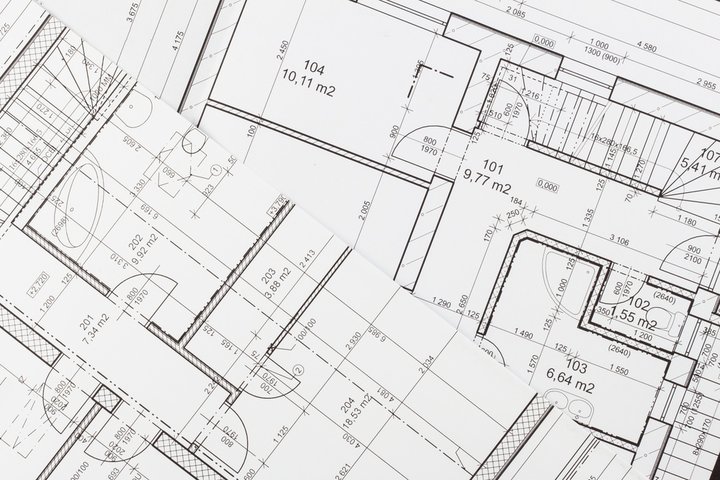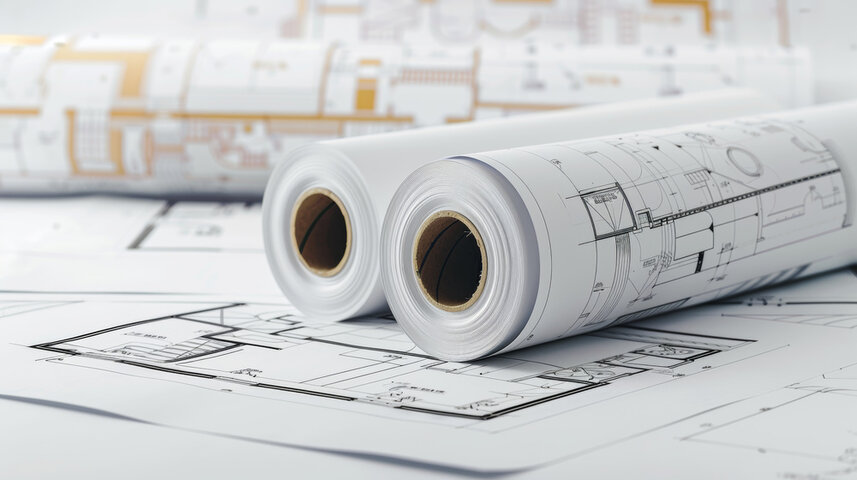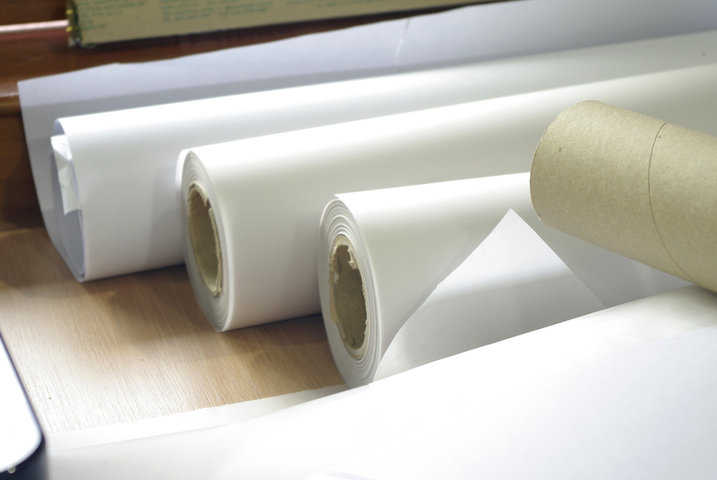
What is plotter paper, and why is it essential for large-format printing? Whether you're an architect drafting blueprints, an engineer creating technical drawings, or a designer working on oversized graphics, choosing the right plotter paper can significantly impact print quality and durability. But with so many types available, how do you know which one to use?
In this post, we’ll explore everything you need to know about plotter paper—what it is, who uses it, and why selecting the right type matters. From bond and vellum to Mylar and coated options, we’ll break down the differences to help you make the best choice for your printing needs.
What Is Plotter Paper?
Plotter paper is a specialized type of paper designed for large-format printing. Unlike standard printer paper, it comes in rolls rather than sheets, allowing seamless printing of technical drawings, blueprints, and posters. It’s optimized for high-precision printing, ensuring crisp lines and accurate details. Engineers, architects, and designers rely on it for CAD drawings and professional graphics.
Why Is It Called Plotter Paper?
The name comes from "plotters"—large-format printers that use a precise mechanical process to create detailed line drawings. Early plotters used pens to "plot" designs on paper, making them ideal for technical and engineering applications. Although modern plotters now use inkjet or laser technology, the term "plotter paper" remains.
Key Features of Plotter Paper
1. Large Format Compatibility
Comes in various widths, typically 17 to 60 inches.
Length varies, with 150-foot and 300-foot rolls being common.
Suitable for wide-format printers and plotters.
2. Surface and Weight Options
Available in smooth, coated, or textured finishes for different printing needs.
Comes in different weights, usually ranging from 20 lb to 36 lb.
3. Print Performance
Designed for sharp lines, high-resolution graphics, and smudge-free printing.
Works with inkjet, laser, and older pen-based plotters.
Common Sizes of Plotter Paper
| Paper Width (inches) | Common Applications |
| 17” - 24” | Small-scale drawings, sketches |
| 30” - 36” | Engineering blueprints, CAD prints |
| 42” - 60” | Posters, banners, large-format graphics |

How Does Plotter Paper Work?
How Plotters Use This Paper
Plotter paper is designed for wide-format printing, allowing precise and uninterrupted large-scale prints. Unlike standard printers that move paper back and forth, plotters feed a continuous roll through rollers while the printhead moves over the surface. This setup ensures sharp lines, consistent output, and accurate alignment for technical drawings, architectural plans, and graphic designs.
Inkjet vs. Laser Plotter Printing
1. Inkjet Plotters
Use liquid ink sprayed through nozzles to create high-resolution prints with sharp details.
Work best with coated and uncoated bond paper, vellum, and photo paper.
Require fast-drying paper to prevent ink smudging and improve print quality.
2. Laser Plotters
Use toner powder fused onto the paper through heat and pressure.
Require heat-resistant paper such as heavy bond or polyester-based films.
Ideal for large-scale monochrome printing with long-lasting durability.
Ink Absorption and Paper Compatibility
| Plotter Type | Best Paper Type | Key Features |
| Inkjet Plotter | Coated paper, vellum, bond | High ink absorption, vibrant colors, fine details |
| Laser Plotter | Heavy bond, polyester film | Heat-resistant, smudge-proof, long-lasting quality |

Types of Plotter Paper
Bond Plotter Paper
Bond plotter paper is a widely used option for technical drawings and blueprints. It is made from high-quality wood pulp, offering durability and a smooth surface for precise ink application.
Weight and Thickness Options
Available in different weights, typically ranging from 20 lb to 36 lb for various printing needs.
Thicker paper provides better durability and reduces ink bleed-through for high-density prints.
Lighter-weight options work well for draft prints and cost-effective large-scale projects.
Common Applications
| Application | Details |
| Engineering and Architectural Industries | Used for CAD drawings, schematics, and design plans. |
| Monochrome and Color Line Work | Ensures clear and legible prints for both monochrome and color prints. |
| Inkjet and Laser Plotters | Works well with both inkjet and laser plotters for professional-quality output. |
Coated Plotter Paper
Matte-Coated vs. Gloss-Coated
Matte-Coated Paper: Reduces glare and provides a smooth, non-reflective finish, ideal for technical drawings.
Gloss-Coated Paper: Enhances color vibrancy and contrast, making it suitable for marketing materials.
Both options prevent ink smudging and improve overall print clarity compared to uncoated paper.
Best Use Cases
| Use Case | Details |
| Graphic Design, Presentations & Marketing | Ideal for materials requiring sharp visuals and vibrant colors. |
| Advertising and Interior Design | Used in industries like advertising and high-end architectural modeling. |
| Inkjet Plotters | Compatible with inkjet plotters for producing detailed and professional prints. |
Vellum Plotter Paper
Advantages for Archival and Tracing
Provides a semi-transparent surface, allowing designers to trace or overlay multiple drawings.
Made from cotton fibers, ensuring long-lasting durability without yellowing over time.
Offers excellent dimensional stability, preventing warping or shrinkage in storage.
Common Industries Using Vellum
| Industry | Details |
| Architectural Firms | Used for blueprint revisions and tracing complex structures. |
| Engineering | Engineers rely on it for overlaying modifications on existing technical drawings. |
| Artists and Illustrators | Used for detailed sketches and preliminary design work. |
Mylar Plotter Paper
Durability and Waterproof Properties
Resistant to tears, creases, and environmental factors like humidity and moisture.
Provides a smooth and durable surface that holds ink without smudging or fading.
Ideal for high-precision printing, ensuring fine lines and sharp details in engineering designs.
Best Applications
| Application | Details |
| Overlay Drawings | Allows multiple revisions without damage, making it perfect for drafts. |
| Maps and Aerospace Schematics | Used in fields like aerospace for highly durable prints. |
| Long-Term Document Storage | Suitable for storing documents for decades without degradation. |
Photo Plotter Paper
Enhancing Color Vibrancy and Resolution
Specially coated to enhance ink absorption, creating sharp, true-to-life colors.
Supports high-resolution printing, capturing fine details with exceptional clarity.
Reduces dot gain, ensuring images appear crisp and well-defined.
Best Uses
| Use Case | Details |
| Poster and Banner Printing | Used in advertising, trade shows, and exhibitions for large-format prints. |
| Photography Studios | Ideal for producing large-format, gallery-quality prints. |
| Inkjet Plotters | Works with inkjet plotters to achieve professional-grade color accuracy and depth. |

Plotter Paper Sizes and Weight
Standard Roll Widths and Lengths
Plotter paper is commonly available in several roll sizes to accommodate different printing needs. The most common roll widths are 24 inches, 36 inches, and 42 inches. These sizes work well for most large-format printers. Roll lengths typically range from 150 feet to 300 feet, depending on the manufacturer. This allows for efficient printing without frequent paper changes.
Common Weights (20lb, 24lb, 36lb, etc.)
Plotter paper comes in various weights, each suited for specific tasks. The most common weights are 20lb, 24lb, and 36lb.
20lb paper is lightweight, ideal for drafts and temporary prints.
24lb paper offers better durability, suitable for professional-grade technical drawings.
36lb paper is heavier, used for high-quality prints and maps that require extra durability.
How to Choose the Right Size and Weight for Your Project
Choosing the correct size and weight depends on the type of print job. If you are printing large technical drawings, opt for wider rolls like 36 inches or 42 inches. For projects that need durability, like high-quality maps, choose heavier paper (36lb). Lighter weights (20lb or 24lb) are sufficient for drafts or less important prints.
How to Choose the Right Plotter Paper
Factors to Consider
Printer Compatibility
Make sure your plotter paper suits the type of printer you're using. Inkjet plotters require papers that absorb ink well, like coated types. Laser plotters, however, work best with uncoated or lightly coated paper as their heat-based printing process can cause smudging on glossy surfaces.
Print Quality Needs
If you're printing technical drawings, choose smooth papers like bond or vellum. These provide crisp lines and prevent ink bleeding. For artistic prints or high-resolution images, go for coated or photo papers that enhance color vibrancy and bring out fine details for high-quality visuals.
Budget Considerations
Your paper choice should match your budget. Lighter papers like 20lb bond are cost-effective for drafts and large prints. If you're after professional-quality results, heavier, coated paper may be a better option, though it comes at a higher cost but provides better durability and print clarity.
Tips for Selecting Paper for Long-Term Storage and Durability
Consider Paper Durability
If you need to store prints for an extended period, choose papers known for their durability, such as vellum, mylar, or coated options. These materials resist fading, yellowing, and damage over time, making them ideal for archival prints and long-lasting displays.
Choose Acid-Free Paper
| Paper Type | Best For | Key Benefits |
| Vellum | Archival projects, tracing | Durable, translucent, and long-lasting. |
| Mylar | Long-term storage | Tear-resistant, waterproof, and stable. |
| Coated Paper | Artistic prints, high-quality images | Enhances color vibrancy, smooth finish. |
Plotter Paper vs. Regular Paper: Key Differences
Differences in Thickness, Durability, and Ink Absorption
Plotter Paper
Thickness:
Plotter paper is thicker, typically 20lb to 36lb, providing more strength and preventing bending or tearing during large prints.
Durability:
It resists wrinkles, tears, and creases, making it ideal for long-term projects and large-format prints without degradation over time.
Ink Absorption:
Plotter paper absorbs ink evenly, ensuring sharp prints without smudging or bleeding, ideal for technical and high-resolution designs.
Regular Paper
Thickness:
Regular paper is thinner, usually 15lb to 20lb, which makes it more prone to tearing and warping under high printing pressures.
Durability:
Regular paper is less durable, easily tearing or wrinkling, making it unsuitable for large-scale prints or long-term storage.
Ink Absorption:
It struggles with ink absorption, leading to smudging and poor print quality, especially in detailed, high-ink applications.
Why Regular Paper Isn’t Suitable for Large-Format Printing
Regular paper is too thin and fragile for large-format printing. It tends to wrinkle, tear, or warp under the pressure of plotters, especially for larger designs. The ink also doesn’t absorb evenly, leading to smudging and blurry prints. Plotter paper’s thickness and smooth surface are better suited for such demanding projects.
Common Uses of Plotter Paper
| Use Case | Description |
| Engineering and Architectural Blueprints | Used for precise, detailed technical drawings and blueprints. |
| Graphic Design and Posters | Ideal for vibrant, sharp prints in large formats like posters and designs. |
| CAD (Computer-Aided Design) Drawings | Provides clear, accurate prints for CAD designs and technical drawings. |
| Business Presentations and Charts | Great for large-scale charts and presentations with clear graphics. |
| Large-Format Maps and Technical Schematics | Perfect for printing large maps and detailed technical schematics. |
How to Store and Handle Plotter Paper
Best Storage Practices to Prevent Curling or Yellowing
Store paper in a cool, dry place, away from direct sunlight.
Keep rolls in a horizontal position to prevent pressure or bending.
Use protective plastic wrapping for long-term storage to avoid moisture and air exposure.
How to Keep Rolls Clean and Dust-Free
Cover rolls with protective bags or covers to shield from dust.
Store rolls in a clean area, away from dirt or debris.
Handle rolls with clean hands or gloves to avoid transferring oils and dirt.
Proper Handling to Avoid Smudging or Damage
Avoid touching the printed surface to prevent smudging.
Always handle paper by the edges to avoid damage.
Unroll paper gently to prevent wrinkles or tears.
Printing Tips for Plotter Paper
How to Prevent Ink Smudging and Paper Jams
Use the right paper type: Ensure your paper suits the printer (inkjet vs. laser) to prevent smudging.
Proper paper loading: Load the paper correctly and avoid overloading the feed tray to minimize jams.
Match printer settings: Adjust the print settings to match the paper type, preventing ink smudging and paper jams.
Keep the printer clean: Regularly clean your printer to reduce dust buildup, which can cause paper jams.
Recommended Print Settings for Different Paper Types
Bond paper: Choose moderate ink settings to avoid ink bleeding.
Coated paper: Select high-resolution settings for vibrant colors and sharp lines.
Vellum/Mylar: Use slower print speeds for smooth, consistent printing on these materials.
Refer to the printer manual: Always follow the recommended settings for each paper type to ensure optimal quality.
How to Ensure the Best Color Accuracy and Resolution
Calibrate the printer: Regular calibration ensures accurate color reproduction.
Use high-quality ink: For vivid colors, use professional-grade ink.
Set to high resolution: Choose “high” or “best” print settings for sharp, clear prints.
Match paper type to print settings: Ensure the paper type aligns with the resolution setting for optimal results.
Conclusion
Plotter paper is essential for large-format printing, offering various types like bond, coated, vellum, and Mylar, each tailored for specific applications. Choosing the right paper ensures quality prints, whether for technical drawings or high-resolution designs.
Consider printer compatibility, print quality needs, and budget when selecting plotter paper. Experimenting with different types based on your project's requirements can lead to better results. Don't hesitate to explore options to find the perfect match for your needs.
Frequently Asked Questions
1. Can plotter paper be used in regular printers?
Plotter paper can be used in regular printers, but it’s designed for large-format printing, so results may vary based on the printer type.
2. How long does plotter paper last?
Plotter paper’s lifespan depends on storage conditions. When stored properly in a cool, dry place, it can last for several years without deteriorating.
3. What’s the difference between coated and uncoated plotter paper?
Coated plotter paper has a smooth, ink-absorbent surface, ideal for high-quality prints. Uncoated paper is more porous and better for general use.


























